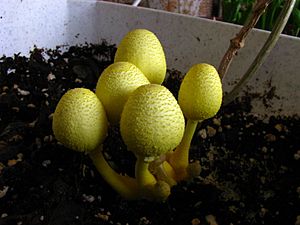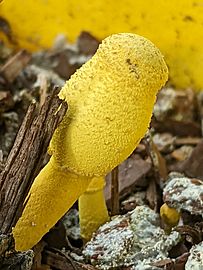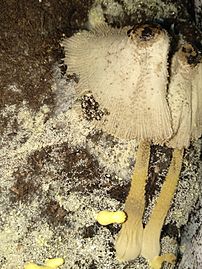Flower pot parasol facts for kids
Quick facts for kids Flower pot parasol |
|
|---|---|
 |
|
 |
|
| Scientific classification | |
| Genus: |
Leucocoprinus
|
| Species: |
birnbaumii
|
| Synonyms | |
|
Species synonymy
Agaricus birnbaumii Corda (1839)
Agaricus luteus Bolton (1789) [nom. illegit., non A. lutea Hudson (1778)] Lepiota lutea (Bolton) Godfrin (1897) Leucocoprinus luteus (Bolton) Locq. (1945) Agaricus flammula Alb. & Schwein. (1805) Lepiota flammula (Alb. & Schwein.) Gillet (1874) Agaricus flos-sulphuris Schnizl. (1851) Lepiota flos-sulphuris (Schnizl.) Mattir. (1918) Leucocoprinus flos-sulphuris (Schnizl.) Cejp (1948) Lepiota aurea Massee (1912) [nom. illegit., non L. aurea (Matt.) Gray (1821)] Lepiota pseudolicmophora Rea (1922) Lepiota coprinoides Beeli (1936) |
|
Leucocoprinus birnbaumii is a bright yellow mushroom that grows in many parts of the world. It is very common in warm, tropical places. In cooler areas, you often find it growing in greenhouses and flowerpots. This is why it's sometimes called the flowerpot parasol or plantpot dapperling. This mushroom is considered poisonous and should never be eaten.
| Leucocoprinus birnbaumii | |
|---|---|
| Mycological characteristics | |
| gills on hymenium | |
| cap is ovate or umbonate | |
| hymenium is free | |
| stipe has a ring | |
| spore print is white | |
| ecology is saprotrophic | |
| edibility: poisonous | |
Contents
Naming the Yellow Mushroom
The Leucocoprinus birnbaumii mushroom has had a few different names over the years! It was first described in 1788 by an English mushroom expert named James Bolton. He called it Agaricus luteus, which means "yellow mushroom." He saw it growing in a warm greenhouse in England.
However, that name had already been used for a different mushroom. So, Bolton's name for this yellow mushroom was not officially allowed.
Later, in 1839, a Czech mushroom expert named August Carl Joseph Corda found the same yellow mushroom. He discovered it growing in a greenhouse in Prague, among pineapple plants. A garden inspector named Birnbaum helped him find it. Because of this, Corda decided to name the mushroom Agaricus Birnbaumii after Mr. Birnbaum.
Finally, in 1962, a German mushroom expert named Rolf Singer gave it its current scientific name: Leucocoprinus birnbaumii.
Common English Names
This mushroom has many fun nicknames! In the UK, it's often called the "plantpot dapperling." In North America, people might call it the "yellow parasol," "flowerpot parasol," "yellow houseplant mushroom," or "lemon-yellow lepiota."
What Does it Look Like?
Leucocoprinus birnbaumii is a small, bright yellow mushroom. You can often spot it in plant pots and greenhouses. These mushrooms usually grow alone or in small groups.
Cap: The top part of the mushroom, called the cap, can be 2 to 7.5 centimeters (about 1 to 3 inches) wide. When it's young, it looks like a bulb or cylinder. As it grows, it opens up to be more like a dome or cone. The cap is usually lemon yellow or sulfur yellow. It might have soft, ragged scales that are darker yellow or brownish, especially in the center. The edges of the cap often have grooves or lines.
Gills: Underneath the cap, you'll find the gills. These are thin, plate-like structures that are also sulfur yellow. They are usually free, meaning they don't touch the stem.
Stem: The stem, or stalk, is 2.5 to 9 centimeters (about 1 to 3.5 inches) long. It's usually thinner at the top and gets wider towards the bottom, like a club. The stem is hollow inside and is also lemon yellow. It has a thin ring around it, which can move up and down the stem. This ring is yellow on top and whitish underneath. Sometimes, the ring disappears as the mushroom gets older.
Spore Print: If you take a spore print, it will be white. Spores are like the mushroom's "seeds."
Smell and Taste: This mushroom doesn't have a strong smell or taste.
Tiny Underground Structures: Sclerotia
Sometimes, you might see tiny, hard, whitish-yellow lumps on the soil surface near these mushrooms. These are called sclerotia. They are like tiny survival pods for the fungus. While you usually hear about sclerotia with truffles, these are much smaller.
These sclerotia are the same fungus as the mushroom itself. They can even grow into new mushrooms if the conditions are right!
If you have Orchids in clear pots, you might see these sclerotia. They don't harm the plants. However, they can make the pot look less pretty, which might affect how people feel about buying the plant.
Where Does it Grow?
Leucocoprinus birnbaumii is a saprotroph. This means it gets its food by breaking down dead plant material, like old leaves or compost.
This mushroom is very common in tropical and subtropical areas. It can also be found in warmer parts of temperate zones. In cooler places like North America, Europe, and Australia, it's usually found indoors in warm, humid places like greenhouses and plant pots, rather than in the wild.
People have helped this mushroom spread all over the world. When explorers brought exotic plants from tropical places back to Europe, they unknowingly brought the mushroom's spores and mycelium (the main body of the fungus) along in the soil. This is why it has been found in European greenhouses for hundreds of years.
Even though it's too cold for this mushroom to live outside in many countries, it keeps spreading because of human activity. Garden centers and plant nurseries are like hubs that help distribute L. birnbaumii to new homes.
If you suddenly see these mushrooms in your plant pot, it doesn't mean the fungus just arrived. It's more likely that the fungus was already in the soil when you got the plant. The mushrooms only appear when the soil is moist enough and the air is humid. Even if you don't see mushrooms, the fungus might still be living happily in the soil, waiting for the right conditions to fruit.
L. birnbaumii is harmless to your plants. In fact, it can even help the soil by breaking down organic matter and releasing nutrients that plants need. However, if you see mushrooms appearing often, it might be a sign that you are watering your plant too much. While this mushroom itself is safe for plants, too much moisture can invite other harmful fungi or mold that could hurt your plant's roots. So, L. birnbaumii can be a helpful sign to check your watering habits!
Similar Yellow Mushrooms
There are a few other yellow mushrooms that look a bit like Leucocoprinus birnbaumii:
- Leucocoprinus straminellus is similar but usually paler, sometimes even whitish. It can also grow in greenhouses.
- Leucocoprinus flavescens has a pale yellow to white cap with a brownish center.
- Leucocoprinus brunneoluteus is another yellow mushroom from South America. It has a noticeable brown bump in the center of its cap.
- Leucoagaricus sulphurellus is a yellow mushroom found in the Caribbean. Its gills turn a bright blue-green if they are bruised.
Is it Safe to Eat?
No! Leucocoprinus birnbaumii is a toxic mushroom. If someone eats it, it can cause an upset stomach. It's important to remember that these mushrooms should never be eaten.
What Makes it Yellow?
The bright yellow color of these mushrooms comes from special natural chemicals called alkaloids, specifically birnbaumins. These chemicals are what give the mushroom its unique color.
Images for kids
See also
 In Spanish: Leucocoprinus birnbaumii para niños
In Spanish: Leucocoprinus birnbaumii para niños








